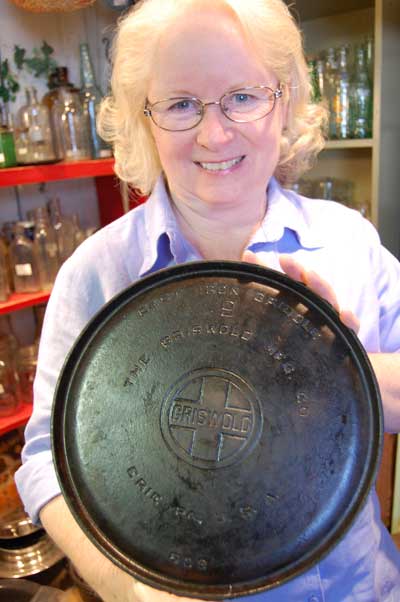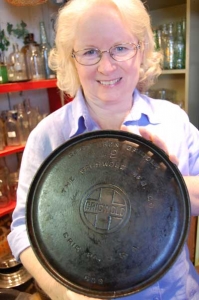Speaking of Antiquing – by Margaret Barnes, Pickety Place Antiques
When it comes to heirlooms, items of value passed from one generation to the next, most people would not expect a clunky old iron pan to be one. If you know what to look for in an iron pan, you could have something of more value than your great grandfather’s pocket watch. Cast iron is so durable that you can take an old rusty pan out of the trash, clean it up, season it, and use it for many more years.
The cookware from the Griswold and Wagner Co.’s from the 1800’s-1900’s are still being used in many kitchens in America, including mine.
Wagner cookware was started in Sidney, Ohio in 1891. They marked their pans in different ways over the years. Some have a plain WAGNER, and a number indicating the skillet size; then later simple SIDNEY. Later still, they incorporated both words. The font change came in early 1914 where the W was large for both Wagner and Ware, with Sidney underneath.
Griswold Manufacturing began making the Erie pans in 1880. The “ERIE” skillet featuring Griswold’s spider trademark is one of the most desirable and rare pieces of cast iron cookware to date. Griswold logos have a circled cross with GRISWOLD in the center. The size of this logo changed many times. Griswold is from Erie, Pennsylvania. So if you just see the logos Erie or Sidney, you will be able to recognize from which company they come.
The numbers on the handle or back of the pan indicate the size, or inches of the pan.
Cast iron cookware, although heavy and durable, is also fragile. Never put your hot lids or pans in cold water as they can crack like glass shattering. If dropped, they can also break or crack. I once set a hot lid on the counter too roughly and it cracked. I still use it many years later and that crack reminds me of its fragility.
These companies made several items for kitchen use, including coffee grinders, waffle irons, griddle pans, meat and grain grinders, corn bread pans, muffin pans, utensils, coffee pots, racks to hold the pots and pans, stoves and heaters, toys and much more.
Dutch Ovens with feet or legs were made to sit above the coals on an open fire. The wire handles were used to suspend the pot over the fire, as well as carrying.
To successfully care for your cast iron requires you to “season” your pan. Many pans get thrown out because the owners think they are beyond using.
Taking the time to fully season in the oven will give your pan a non-stick cooking surface and restore its beauty. To season, completely clean and dry the cast iron pan. Put it in the oven and heat to 450 F. Remove and let it cool until you can touch it. Then, using Crisco or Lard on a rag, wipe the entire surface lightly and uniformly. Put it back in the oven for 30 minutes at 400 F. Turn off the oven and leave pan in to cool. This should give your pan a shiny patina. Repeat this every 6 months or so depending on need.
Lastly, NEVER put your pans in a dishwasher or use an abrasive scrubber. When needed, soak them for a short time in water to soften cooked-on foods. You might want to avoid using soap when possible and simply wipe cast iron clean while still warm after cooking.
Pickety Place Antiques & Collectibles is located at 130 N. 4th Street, Historic Jacksonville, Oregon.
Posted August 12, 2013


 Margaret Barns is co-owner of Pickety Place Antiques & Collectibles located at 130 N. 4th Street in Jacksonville. LIKE them on
Margaret Barns is co-owner of Pickety Place Antiques & Collectibles located at 130 N. 4th Street in Jacksonville. LIKE them on